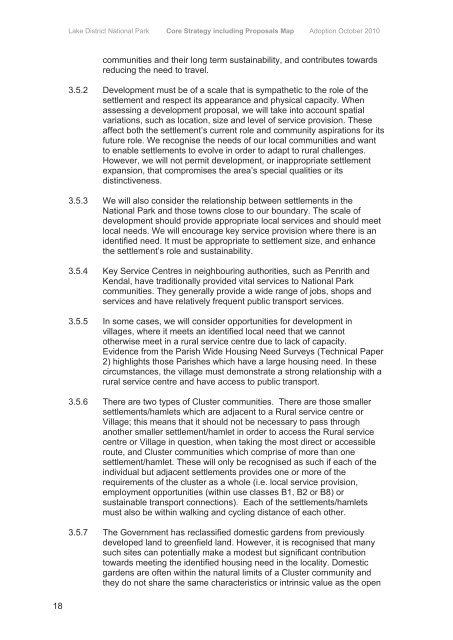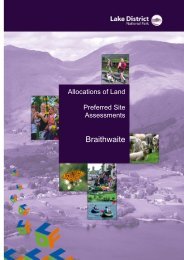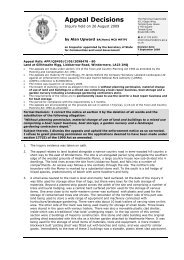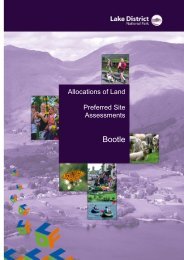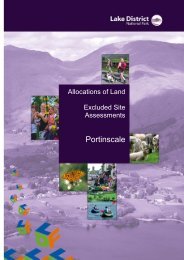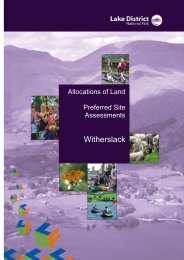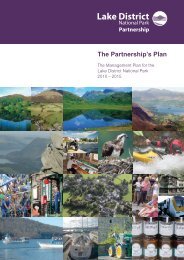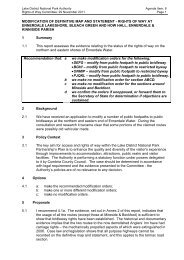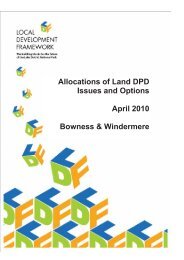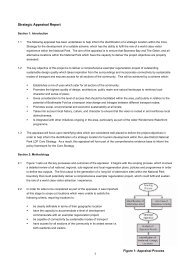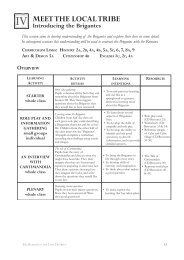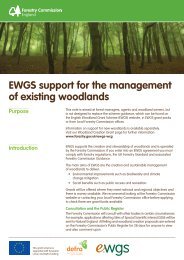Core Strategy (PDF) - Lake District National Park
Core Strategy (PDF) - Lake District National Park
Core Strategy (PDF) - Lake District National Park
Create successful ePaper yourself
Turn your PDF publications into a flip-book with our unique Google optimized e-Paper software.
<strong>Lake</strong> <strong>District</strong> <strong>National</strong> <strong>Park</strong> <strong>Core</strong> <strong>Strategy</strong> including Proposals Map Adoption October 2010<br />
communities and their long term sustainability, and contributes towards<br />
reducing the need to travel.<br />
3.5.2 Development must be of a scale that is sympathetic to the role of the<br />
settlement and respect its appearance and physical capacity. When<br />
assessing a development proposal, we will take into account spatial<br />
variations, such as location, size and level of service provision. These<br />
affect both the settlement’s current role and community aspirations for its<br />
future role. We recognise the needs of our local communities and want<br />
to enable settlements to evolve in order to adapt to rural challenges.<br />
However, we will not permit development, or inappropriate settlement<br />
expansion, that compromises the area’s special qualities or its<br />
distinctiveness.<br />
3.5.3 We will also consider the relationship between settlements in the<br />
<strong>National</strong> <strong>Park</strong> and those towns close to our boundary. The scale of<br />
development should provide appropriate local services and should meet<br />
local needs. We will encourage key service provision where there is an<br />
identified need. It must be appropriate to settlement size, and enhance<br />
the settlement’s role and sustainability.<br />
3.5.4 Key Service Centres in neighbouring authorities, such as Penrith and<br />
Kendal, have traditionally provided vital services to <strong>National</strong> <strong>Park</strong><br />
communities. They generally provide a wide range of jobs, shops and<br />
services and have relatively frequent public transport services.<br />
3.5.5 In some cases, we will consider opportunities for development in<br />
villages, where it meets an identified local need that we cannot<br />
otherwise meet in a rural service centre due to lack of capacity.<br />
Evidence from the Parish Wide Housing Need Surveys (Technical Paper<br />
2) highlights those Parishes which have a large housing need. In these<br />
circumstances, the village must demonstrate a strong relationship with a<br />
rural service centre and have access to public transport.<br />
3.5.6 There are two types of Cluster communities. There are those smaller<br />
settlements/hamlets which are adjacent to a Rural service centre or<br />
Village; this means that it should not be necessary to pass through<br />
another smaller settlement/hamlet in order to access the Rural service<br />
centre or Village in question, when taking the most direct or accessible<br />
route, and Cluster communities which comprise of more than one<br />
settlement/hamlet. These will only be recognised as such if each of the<br />
individual but adjacent settlements provides one or more of the<br />
requirements of the cluster as a whole (i.e. local service provision,<br />
employment opportunities (within use classes B1, B2 or B8) or<br />
sustainable transport connections). Each of the settlements/hamlets<br />
must also be within walking and cycling distance of each other.<br />
3.5.7 The Government has reclassified domestic gardens from previously<br />
developed land to greenfield land. However, it is recognised that many<br />
such sites can potentially make a modest but significant contribution<br />
towards meeting the identified housing need in the locality. Domestic<br />
gardens are often within the natural limits of a Cluster community and<br />
they do not share the same characteristics or intrinsic value as the open<br />
18


